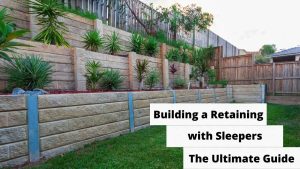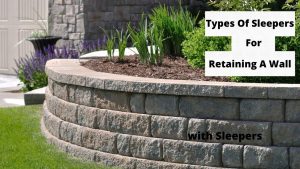How to build a retaining wall with sleepers
There are many ways to build a retaining wall and each has its own advantages and disadvantages. In this article, we’re going to focus on how to build a retaining wall with sleepers. Cement sleepers are one of the most popular choices for building vertical retaining walls as they’re easy to install and can be created with DIY tools.
Another plus is that cement sleepers won’t rot, making them a durable option for your wall. To begin, you’ll need to lay out your foundation for the wall. This could be done by digging into the ground and placing concrete footings or using metal spikes to anchor the sleeper in place. Once your foundation is in place, you can start assembling the wall by stacking the cement sleepers on top of each other. Be sure to leave a small gap between each sleeper so that there’s room for mortar later on.
Once you’ve reached the desired height, use mortar to fill in the gaps between the sleepers and secure them in place. Finally, give your retaining wall a coat of paint or sealant to protect it from weathering and staining over time
The benefits of using sleepers to build a retaining wall
When it comes to building a retaining wall, there are a few different materials you can use. Sleepers are one option that many people choose because of the benefits they offer. Some of the key benefits of using sleepers to build a retaining wall include:
1. Concrete sleepers are strong and durable, and they won’t rot as timber sleepers would.
2. They’re a low-maintenance option that can also add some colour to your landscape!
3. Retaining walls are great for levelling and retaining soil.
4. They can be used in a variety of applications, including creating a protective barrier on the property line or preventing soil displacement by streams.
5. Retaining walls are easy to install, even for DIYers!
The different types of sleepers available for use in building a retaining wall
There are many different types of sleepers available for use in building a retaining wall. At APC, we offer both steel-reinforced and structurally sound units made from cement. Our cement sleepers in Adelaide are perfect for vertical retaining walls.
If you’re looking for a more budget-friendly option, there are many other ways to build a retaining wall. The 2006 International Building Code is a great resource for finding the best engineering design for your project. The book is 225 pages long, with a table of contents, index and more. It was written by Crosbie and Watson in 2005.
Short descriptions allow for quick overviews of information without overwhelming readers with too much detail or a long list of links. GND identifiers refer to Geotechnical Shoring Structures, while BNF and LCCN identifiers refer to building types such as block walls and concrete walls
The best way to secure sleepers when building a retaining wall
When building a retaining wall, it is important to make sure that the sleepers are secure. This can be done in a few ways:
1) Concrete Sleepers: These come with pre-drilled holes which can be used to attach them to the foundation. The sleepers should be constructed using the same standard of care as a bridge.
2) Steel-Reinforced & Structurally Sound Concrete Sleepers: These are available for purchase at APC, but they must be ordered online since the company does not carry them in stock. However, they are worth the investment because they are reinforced with steel and will stand up to even the most severe weather conditions.
3) Timber Pile Wall: This type of wall is made from timber piles that have been driven into the ground. The piles should be spaced at regular intervals and attached to each other with metal brackets. It is important that these walls are built correctly, or else they may collapse under pressure.
4) Masonry Block Retaining Wall: This type of wall is made from masonry blocks that have been laid in mortar. The blocks should be arranged so that each one rests on two or more others, forming a stable structure.
The importance of drainage when building a retaining wall with sleepers
When building a retaining wall, it is important to account for drainage. This is because the weight of the soil being held back by the wall can cause water to accumulate behind the structure, which can lead to instability and even collapse. In addition, if water accumulates too quickly, it can damage the retaining wall and surrounding property.
There are two ways to address lateral earth pressures: either by building a drainage system or creating a retaining wall with vertical soil supports. A drainage ditch should be installed before the wall if there is heavy clay or sand, as this will help water flow away quickly and prevent it from accumulating behind the structure. If you have well-drained ground, then you may not need a drainage system; however, it is still advisable to use some form of drainage material in order to improve stability and reduce the risk of collapse.
The best way to finish the surface of a wall built with sleepers
There are a few ways to finish the surface of a retaining wall built with sleepers. One popular option is to create a bed with blocks. This method is easy and quick, and it results in a smooth, finished surface. Another option is to use mortar to attach the sleepers together. This method is more labour-intensive but can give your wall a more polished look.
Finally, you could also simply leave the surface of the retaining wall as is, without any finishing touches. While this may not be as aesthetically pleasing as some of the other options, it is still an acceptable solution that will prevent soil erosion and keep your retaining wall functioning properly.
How to build a wall with sleepers on a slope
If you’re looking for an easy way to build a wall on a slope, then using sleepers is the way to go. Sleepers are wooden boards that are laid horizontally across the slope and then attached to each other with nails or screws. This creates a “wall” of sleepers that can be used to hold soil in place and prevent it from eroding.
One advantage of using sleepers is that they are much cheaper than concrete blocks or bricks. Another advantage is that they are very easy to install, even if you don’t have any construction experience. All you need is a few basic tools like a hammer, screwdriver, and drill.
The disadvantage of using sleepers is that they are not as durable as concrete blocks and may eventually rot or decay over time. They also require regular maintenance to keep them in good condition.
If you’re looking for an easy-to-install and affordable retaining wall solution, then sleeper walls might be right for you!
The best way to build a curve retaining wall with sleepers
When building a different structural retaining wall, there are many different materials that can be used. The most popular material for soil retaining walls is Besser blocks, as they come in many shapes and sizes, and can be mortared together to create a strong wall. However, other materials like concrete retaining wall blocks or segmental wall blocks can also be used to great effect.
Whichever material you choose, the process of building the wall is largely the same: dig a trench along the desired length of the wall (making sure it’s wide enough to fit the blocks), lay down some hardcore at the bottom of the trench (to provide a solid base), stack up your blocks according to your plan, and then mortar them together. Make sure that each block is level with its neighbours before mortar sets; this will help ensure that your finished wall is stable and looks neat and tidy.
If you’re looking to build a curved wall, things get just a little bit more complicated. You’ll need to use sleepers–pieces of wood that act as brackets between each block–in order for it to curve correctly. First, mark out where you want your curve on the ground using rope or spray paint; then set out your sleepers accordingly. Once you’ve got them in place, start stacking your blocks on top just as you would for a straight wall. When you reach the end of the curve, cut some blocks to size and mortar them into place; then repeat the process on the other side.
It’s important to remember that because sleepers add extra stability to a curved wall, they can also make it more difficult to install than a straight wall. Make sure that you have plenty of helpers when putting together a curved retaining wall!
Building a retaining wall with sleepers – common mistakes to avoid
When building a wall with sleepers, there are some common mistakes that you will want to avoid. One of the most important is not considering how much weight the wall will support. You also need to be aware of your surroundings and take into account any existing structures nearby.
Another mistake that people often make is not using an engineer or experienced builder. It is essential to have someone with knowledge and experience in order to build a safe and effective retaining wall.
A third mistake is not getting a building license for a substantial retaining wall. A minor retaining wall may sometimes be constructed without the approval of the City, but it’s always best to check with your local authorities beforehand.
Lastly, don’t forget about sustainability when designing your retaining wall! There are many sustainable options available, such as Global Greengage certification.
Building a retaining wall with sleepers – FAQs
What is a retaining wall?
A retaining wall is a structure that holds back soil or rock from a slope. It is usually made of concrete, masonry, timber, or steel.
Do I need development approval to build a retaining wall?
It depends on the extent of the work. If you are building a garden wall or sleeper wall less than 1 meter high, you don’t need development approval. If you are building anything higher, you will need to apply for both a building license and development approval.
How deep do I have to dig the post holes for my retaining wall?
The hole should be at least half the width of the post and 1 meter deep. You can use concrete instead of digging holes if you wish.
What type of sleepers should I use for my Retaining Wall?
There are many types of sleepers available, including treated pine, hardwood, and concrete sleepers. Concrete sleepers are popular because they are durable and won’t rot like timber sleepers might.
Can I use Adbri blocks to build my Retaining Wall?
Yes! Adbri blocks are designed for this purpose and can be used to create walls of all heights.
How high can my retaining wall be?
There is no maximum height for a retaining wall, but it must comply with the City’s building regulations.
What type of mortar do I need to use for my retaining wall?
Mortar is not necessary when using Adbri blocks, as the blocks are designed to interlock and stack together.


